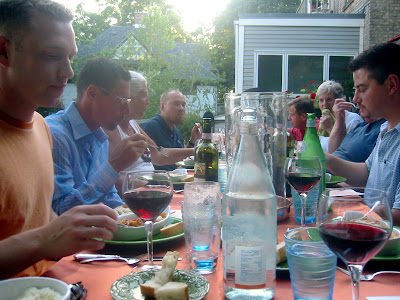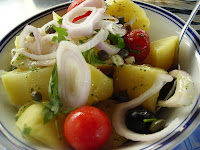Blueberries as big as the end of your thumb,
Real sky-blue, and heavy, and ready to drum
In the cavernous pail of the first one to come!
All ripe together, none of them green.
—Robert Frost
I love blueberries. Use to be they were only available fresh in the summer. That’s no longer true – they now ship them in from New Zealand during the winter, but summer is still the best time to enjoy them. Blueberries grow all over their native North America. There are basically two varieties: the lowbush or wild blueberries and the highbush or cultivated blueberries. Some species of huckleberries, especially in the South, are incorrectly called blueberries. Maine and Canada produce most of the wild variety and you can frequently find them frozen at the grocery (Trader Joe’s, Whole Foods and Woodman’s). Wild blueberries are smaller and intensely flavored and rarely sold fresh around here. (They can be ordered in season from G. M. Allen & Sons, Blue Hill, Maine.) Fortunately for us, our neighbor Michigan leads the country in the production of the cultivated variety and you can easily find them here, fresh and excellent. Blueberries grow in Wisconsin and start appearing around the middle of July (later in the month the farther north you go). You probably won’t see them at the supermarket, but they are available at Farmers’ Markets.
One of the things I like about blueberries is their versatility. Unlike strawberries and raspberries which I prefer raw, blueberries are just as good if not better cooked. They also freeze suitably and frozen blueberries work well in many baked goods and fillings. There is a difference of opinion about whether to defrost or not to defrost frozen blueberries before using. Defrosted berries tend to bleed and discolor cake and muffin batters but frozen berries may substantially increase the cooking time for a pie. Dried blueberries are very sweet and nice in scones and salads. Canned blueberries, however, are best left alone.
Blueberry pie is truly more All American than apple. (The English were making apple pies long before they step foot in North American and nary saw a blueberry till they did). The trouble with blueberry pie is it can be runny. Adding enough thickening – flour, cornstarch or tapioca – can make it plastic. Not too many summers ago I encountered at Connie’s Bakery in Provincetown what was for me the perfect solution: peach blueberry pie. The addition of peaches makes for a firmer filling as well as a novel change. It’s a winning combination of two fruits at the peak of their season that compliment each other like strawberry and rhubarb. Speaking of rhubarb … try adding it to blueberries for “blubarb” pie – quickly becoming one of my favorite summer treats.
Admittedly, making successful pies take some effort and practice ... and I abhor pies made with refrigerated or frozen ready made crusts! If you’re just not up to making a pie for whatever reason, try something more rustic. Blueberry buckle, crumble or crisp are easy to make, just as satisfying and equally delicious warm from the oven.
And … who would have thought something that tastes so good could be good for you? The U.S. Department of Agriculture determined that the antioxidant, pterostilbene, found in blueberries, plays an important role in reducing cholesterol. Antioxidants supposedly also help keep us young and healthy, fight cell-damaging free radicals and prevent various diseases. Regardless, I’d eat them any way.
 Peach Blueberry Pie
Peach Blueberry PiePie pastry for a double crust pie, chilled at least 1 hour
5 ripe medium-size peaches, peeled, pitted and sliced
1 pint blueberries
1 teaspoon grated lemon zest
1 tablespoon fresh lemon juice
¾ cup plus 1 tablespoon granulated sugar
3 to 4 tablespoons instant tapioca, pulverized in a food processor or spice grinder
¼ teaspoon sea salt
1 tablespoon cold butter, cut into bits
1 egg, beaten to combine
Vanilla ice cream (optional)
Roll out half the pie pastry and use it to line a 9-inch pie plate. Trim the edge to about a ½-inch overhang and chill while preparing the filling.
Put the peaches and blueberries in a large mixing bowl and add the lemon zest and juice. Combine ¾ cup sugar, tapioca and salt and add to the fruit. Gently toss to combine and let stand while rolling out the pastry for the top crust.
Roll out the remaining pastry to a 10-inch round. Fill the chilled pastry-lined pie plate with the fruit mixture and dot the surface with butter bits. Lay the rolled-out pastry over the fruit filling. Trim, crimp the edges and make 4 holes in the top crust toward the center of the pie. Chill the pie for 1 hour, then place in the freezer for exactly 20 minutes.
Preheat oven to 400 degrees.
Move the oven racks to the bottom third of the oven.
Place a baking sheet on the lower rack.
Brush the surface of the pie (not the crimped edge) with the beaten egg and sprinkle with the remaining 1 tablespoon sugar. Place in the oven and bake at 400 degrees for 30 minutes. Reduce oven temperature to 350 degrees and continue to bake another 30 minutes or until the crust is golden brown and the juices are bubbling up through the vents. Cool on a rack at least 2 hours before serving. Serve with vanilla ice cream if desired.
6 to 8 Servings.













